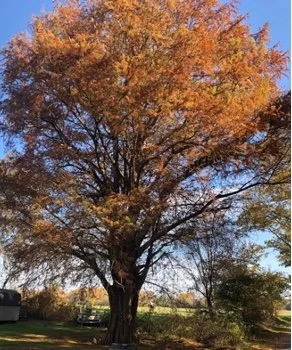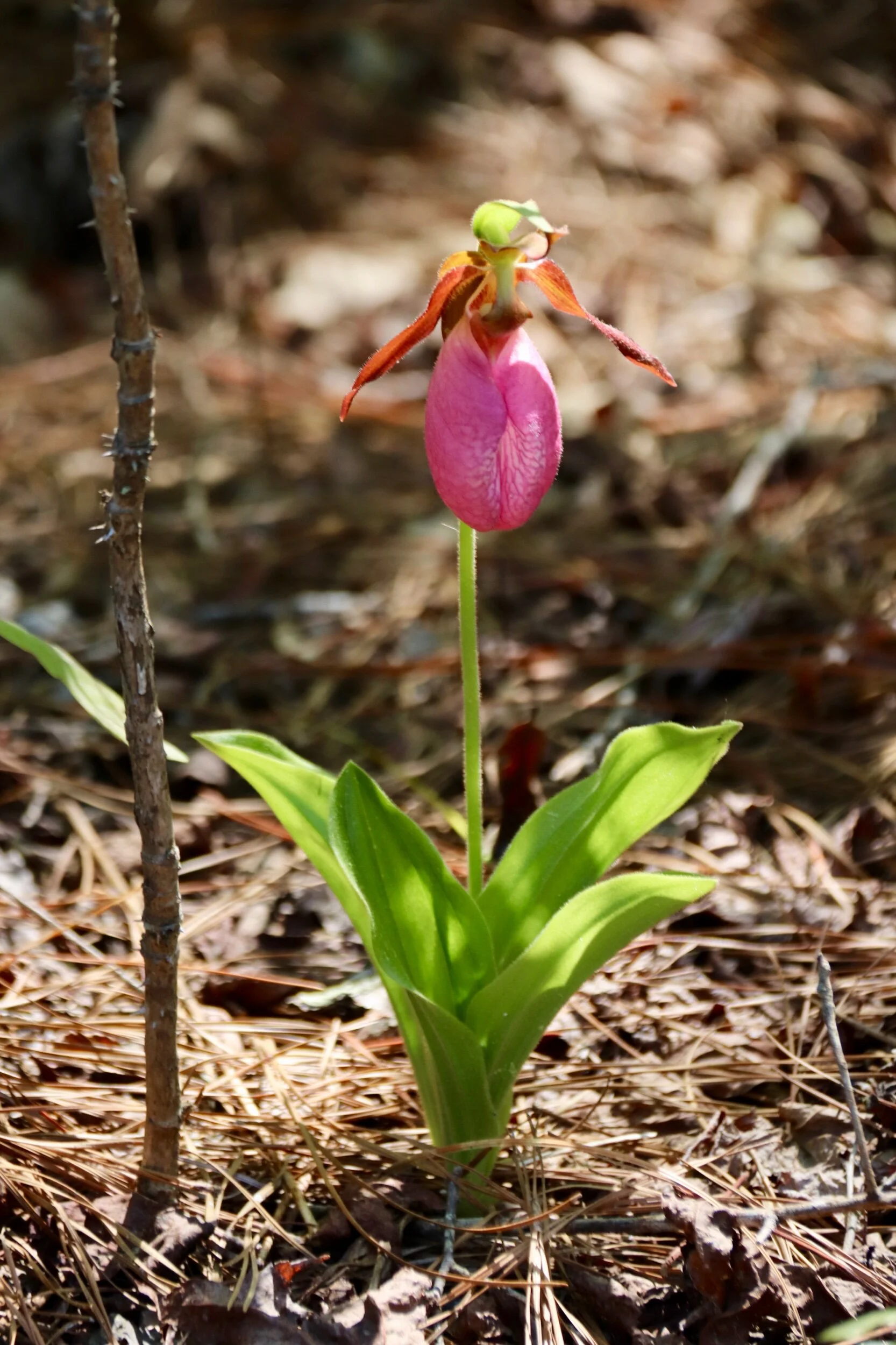The April Plant of the Month, Pawpaw, Asimina triloba, is a handsome small tree that is as fascinating as it is curious. Pawpaw is a member of the Custard-Apple Family, the Annonaceae, a large family of tropical and subtropical species.
Read MoreTrout Lily is one of our earliest woodland wildflowers to bloom each spring with exquisite nodding yellow flowers with back-swept petals. The entire plant is only 4 -6” high with smooth lance to oblong gray-green leaves exquisitely mottled with purplish brown, supposedly resembling dappled coloring of a Brook Trout.
Read MoreGreetings to all our members from your President and Board of Directors, Although we have been in pandemic mode for two years, we have managed to hold two very successful plant sales in 2020 and 2021.
Read MorePartridge-berry is a handsome evergreen vine that creeps along the ground reaching only 2” high. Its long trailing stems can reach 12” long but it develops roots at nodes along the stem wherever it touches the ground, creating large dense colonies.
Read MoreOur deciduous woods are graced by many native ferns, but in winter the evergreen Christmas Fern, Polystichum acrostichoides, takes center stage. It literally lights up the woods with its rich green, lustrous foliage that catches the low-angled winter sun, adding sparkle and color. Christmas Ferns are one of the most common ferns in the Southeast and occur in every county in Virginia.
Read MoreThe December Plant of the Month, American Mistletoe, goes by several common names - American, Eastern, Oak, False, or Hairy Mistletoe. This evergreen shrub grows high in the branches of deciduous trees where it is most visible in winter after the leaves fall. While not a plant you would “plant” in your garden, it has a fascinating history centered around the holidays and winter solstice.
Read MoreBaldcypress, Taxodium distichum, our November Plant of the Month, is an unforgettable sight all year but in late fall when its soft foliage turns vibrant shades of copper-orange, it lights up the entire landscape.
Read MoreIn honor of the Halloween season, the October Plant of the Month is Ghost Plant or Indian Pipe – a very unusual member of the Heath family which includes blueberries, rhododendrons, and azaleas. This small perennial is often mistaken for a fungus with its ghostly white, green waxy, translucent stems and flowers. It completely lacks chlorophyll which gives plants their green color, so cannot photosynthesize or obtain energy from the sun. Instead, it obtains its nutrients by parasitizing the fungi that have symbiotic relationships with trees such as oaks and pines.
Read MoreMistflower, Blue Mist Flower or Hardy Ageratum, Conoclinium coelestinum, is aptly named for the soft clouds of fuzzy, lavender-blue flowers that top the plant in late summer and fall. Mistflower is a mounded and often densely branched, spreading perennial. Formerly classified in the genus Eupatorium, along with its larger cousins, the Joe-pye-weeds and Bonesets, Mistflower is much smaller, reaching only 1.5 - 3’ tall and wide. It also differs from its taller cousins in having opposite leaves that are rhomboid or triangular in shape with blunt teeth along the margins instead of having leaves in a whorl around the stem, and for the soft blue flowers unlike the soft mauve flowerheads of the Joe-pye-weeds and the white flowers of the bonesets. The lovely soft blue flowers cover the plant from late July well into fall, blooming for two months or more. The flowers consist entirely of tubular “disk” florets without the showy ray flowers of many daisies and asters. These small lavender-blue tubular florets are held in flat clusters about 1 – 3” across, with 40 – 50 disk florets in each flowerhead. The style (female reproductive part) extends beyond the corolla and is divided into 2 threadlike parts giving the flowerheads a distinctive misty or fuzzy look. In fact the soft blue flowers look much like the annual garden ageratum, and it is sometimes called hardy or wild ageratum.
Read MoreMost of us who garden, whether with mostly native Virginia plants or otherwise, are familiar with the invasive Asiatic dayflower, Commelina communis, a weedy annual.
When I began botanizing on behalf of the Northern Neck Native Plant Society with Marie Minor in 2007, she told me that there is a perennial native Virginia dayflower, Commelina virginica, which looks similar but has THREE larger blue petals. In my recollection, I have never found this plant, native to the Northern Neck, on the Northern Neck. I was desirous of this native for my garden!
Read MoreJoe-pye-weeds, Eutrochium, are among our most dramatic late summer perennials lighting up both fields and gardens. They have distinctive leaves arranged in whorls at intervals along sturdy stems, topped with large rosy- purple to soft mauve pink flowerheads. These late season beauties begin to bloom in late July and often continue blooming well into September and are superlative pollinator plants, attracting clouds of butterflies, bees, and more.
Hollow Joe-pye-weed, Eutrochium fistulosum, is one of the most dramatic, with tall statuesque stems that can soar to 8 or 9’ in height (more typically 5 – 7’) creating a stunning spectacle.
Read MoreAll of the species of Mountain-mints are virtual pollinator and butterfly magnets! They are always ‘humming’ with butterflies and pollinators and their handsome foliage and long-lasting flowers make them summer garden stars. Of the twelve species in Virginia, Narrow-leaf Mountain-Mint is certainly one of the most attractive and is one of the easiest to grow. It is found in both Richmond and Lancaster Counties in Northern Neck and most other counties in Virginia. It is common in the Mountains and Piedmont but occurs less frequently in the coastal plain.
Read MoreJune is always an exciting month in the many freshwater wetlands in Northern Neck and beyond as many plants come into bloom. And one of the showiest blooms belongs to our beautiful Swamp Rose, Rosa palustris, an upright, deciduous shrub typically reaching 3 – 6’ high and wide, with arching stems and profusion of richly fragrant rose-pink blooms from late May through June.
Read MoreAs a state employee, I appreciated what your administration did several years ago to encourage folks to visit Capitol Square.
That space is a true jewel that can be, and should be, used to show off the Commonwealth to the rest of the country and to the world. It is now used to highlight figures from the state’s history from the Native Americans who lived here for centuries to George Washington to Barbara Johns to leading women. Overlooking it all is the magnificent Capitol designed by Virginia native Thomas Jefferson.
I propose that it now be used to also showcase other things native to Virginia—its plants. Transforming Capitol Square into a Virginia native plant public garden would be a lasting ecological gift your administration could give to Virginia and its citizens.
Read MoreNarrow-leaved Blue-eyed Grass is a lovely small perennial typically reaching only 6 – 12” high and wide but in late spring it lights up the landscape wherever it grows. This is a “grass” only in name as it is a member of the Iris family, with linear, flattened grass-like foliage that grows in dense, tufted clumps from rhizomes.
Read MoreToday, the first day of April, has dawned cold with rain and winds after a week of mild weather, and I seek solace in the first harbingers of spring. A hike to Cabin Swamp in Hickory Hollow Natural Area Preserve is just the spring tonic needed. Sure enough, the showy Marsh Marigolds, Caltha palustris, are already in bloom, flaunting their showy bright yellow flowers above mounds of glossy green foliage.
Read MoreIn the recent House and Home magazine, there’s an article about native wildflowers of the Northern Neck with a name you might recognize.
http://thehouseandhomemagazine.com/culture/wild-jewels-of-the-northern-neck/
Read MoreAs signs of spring fill the air, I find myself eagerly anticipating the vibrant magenta pink blooms of one of our most beautiful flowering trees, the Eastern Redbud, Cercis canadensis. This small tree is a common sight along roadsides, woodland edges, and old fields in Virginia in late March and early April when its showy flowers create a lovely haze of magenta in the spring landscape.
Read More

